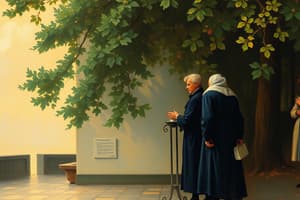Podcast
Questions and Answers
What is the primary focus of macrosociology?
What is the primary focus of macrosociology?
- Cultural and subcultural differences
- Social structures and institutions at a large scale (correct)
- Small groups and their interactions
- Individual people and their behaviors
What is the main goal of macrosociology?
What is the main goal of macrosociology?
- To analyze the interactions between small groups
- To understand the behaviors of subcultures
- To identify patterns and trends in large populations (correct)
- To study the effects of individual actions on societies
What type of data is typically collected in macrosociology?
What type of data is typically collected in macrosociology?
- Case studies of small groups
- Qualitative data from individual interviews
- Statistical data from large populations (correct)
- Ethnographic data from cultural observations
What is a potential pitfall of macrosociology research?
What is a potential pitfall of macrosociology research?
Which social theory is associated with the macro perspective?
Which social theory is associated with the macro perspective?
What is a topic that macrosociology might examine?
What is a topic that macrosociology might examine?
What is the benefit of having a clear perspective when studying societies?
What is the benefit of having a clear perspective when studying societies?
What type of analysis is used in macrosociology to understand large collectives?
What type of analysis is used in macrosociology to understand large collectives?
What is the primary focus of functionalism in sociology?
What is the primary focus of functionalism in sociology?
What is the main idea of conflict theory in sociology?
What is the main idea of conflict theory in sociology?
What is the focus of microsociology?
What is the focus of microsociology?
How does microsociology differ from macrosociology?
How does microsociology differ from macrosociology?
What is the primary concern of symbolic interactionism?
What is the primary concern of symbolic interactionism?
What is the approach of macrosociology?
What is the approach of macrosociology?
What is an example of microsociology in practice?
What is an example of microsociology in practice?
What is the difference between macrosociology and microsociology in terms of their approach?
What is the difference between macrosociology and microsociology in terms of their approach?
What is the main difference between examining a whole civilization and analyzing small groups and individuals?
What is the main difference between examining a whole civilization and analyzing small groups and individuals?
What is the primary concern when analyzing statistical data in macrosociology?
What is the primary concern when analyzing statistical data in macrosociology?
What is a characteristic of macrosociology in terms of the type of phenomena studied?
What is a characteristic of macrosociology in terms of the type of phenomena studied?
What is the primary benefit of having a clear perspective when studying societies?
What is the primary benefit of having a clear perspective when studying societies?
What is an example of a topic that macrosociology might examine?
What is an example of a topic that macrosociology might examine?
What is the primary goal of macrosociology in terms of understanding the data?
What is the primary goal of macrosociology in terms of understanding the data?
What is a characteristic of functionalism in sociology?
What is a characteristic of functionalism in sociology?
What is the primary concern when analyzing large collectives in macrosociology?
What is the primary concern when analyzing large collectives in macrosociology?
Which sociological perspective examines how institutions adapt to maintain social stability?
Which sociological perspective examines how institutions adapt to maintain social stability?
What is the primary concern of conflict theory in sociology?
What is the primary concern of conflict theory in sociology?
Which of the following is an example of microsociology in practice?
Which of the following is an example of microsociology in practice?
What is the key difference between macrosociology and microsociology?
What is the key difference between macrosociology and microsociology?
What is the primary focus of symbolic interactionism?
What is the primary focus of symbolic interactionism?
Which perspective is concerned with the ways in which social institutions create and maintain social inequalities?
Which perspective is concerned with the ways in which social institutions create and maintain social inequalities?
What is the approach of microsociology to understanding social structures?
What is the approach of microsociology to understanding social structures?
Which perspective is characterized by a focus on the big picture and the examination of large-scale social structures?
Which perspective is characterized by a focus on the big picture and the examination of large-scale social structures?
What is the main focus of macrosociology?
What is the main focus of macrosociology?
What is a potential issue with analyzing data in macrosociology?
What is a potential issue with analyzing data in macrosociology?
What is an example of a topic that macrosociology might examine?
What is an example of a topic that macrosociology might examine?
What is the primary benefit of having a clear perspective when studying societies?
What is the primary benefit of having a clear perspective when studying societies?
What is the focus of macrosociology when analyzing large collectives?
What is the focus of macrosociology when analyzing large collectives?
What is a characteristic of macrosociology?
What is a characteristic of macrosociology?
What is the primary goal of macrosociology?
What is the primary goal of macrosociology?
What is associated with the macro perspective?
What is associated with the macro perspective?
What is the primary focus of functionalism in sociology?
What is the primary focus of functionalism in sociology?
What is the main idea of conflict theory in sociology?
What is the main idea of conflict theory in sociology?
What is the primary focus of microsociology?
What is the primary focus of microsociology?
What is the approach of microsociology to understanding social structures?
What is the approach of microsociology to understanding social structures?
What is the primary concern of symbolic interactionism?
What is the primary concern of symbolic interactionism?
What is the key difference between macrosociology and microsociology?
What is the key difference between macrosociology and microsociology?
What does conflict theory propose about societies?
What does conflict theory propose about societies?
What is the primary focus of macrosociology?
What is the primary focus of macrosociology?
Flashcards are hidden until you start studying
Study Notes
Levels of Analysis in Sociology
- Sociologists use two main levels of analysis: macrosociology and microsociology
- These levels help to study societies by providing a starting point for analysis
Macrosociology
- Focuses on the large-scale perspective
- Examines big phenomena that affect a whole population or a large portion of it
- Looks at social structures and institutions, whole civilizations or societies, and patterns
- Analyzes large collectives like cities for broad social trends
- Uses statistical data, but requires careful analysis to avoid bias
- Deals with matters like war, poverty, healthcare institutions, and international issues
- Functionalism and Conflict Theory are social theories that emerge from the macro perspective
- Functionalism looks at how institutions adapt to keep society stable and functioning
- Conflict Theory states that societies are made up of institutions that benefit the powerful and create inequalities
Microsociology
- Focuses on the small scale, everyday, face-to-face social interactions between individuals or small groups
- Examines families, schools, and other small social interactions
- Uses interpretive analysis, looking at a sample of society and interpreting how individual interactions affect larger patterns
- Analyzes how individual interactions affect institutions and social structures
- Examines specific interactions, such as teacher-student or doctor-patient relationships, and their impact on society
- Symbolic Interactionism is a social theory that emerges from the micro perspective, focusing on the individual and the meaning they give to objects, events, and symbols.
Levels of Analysis in Sociology
- Sociologists use two main levels of analysis: macrosociology and microsociology
- These levels help to study societies by providing a starting point for analysis
Macrosociology
- Focuses on the large-scale perspective
- Examines big phenomena that affect a whole population or a large portion of it
- Looks at social structures and institutions, whole civilizations or societies, and patterns
- Analyzes large collectives like cities for broad social trends
- Uses statistical data, but requires careful analysis to avoid bias
- Deals with matters like war, poverty, healthcare institutions, and international issues
- Functionalism and Conflict Theory are social theories that emerge from the macro perspective
- Functionalism looks at how institutions adapt to keep society stable and functioning
- Conflict Theory states that societies are made up of institutions that benefit the powerful and create inequalities
Microsociology
- Focuses on the small scale, everyday, face-to-face social interactions between individuals or small groups
- Examines families, schools, and other small social interactions
- Uses interpretive analysis, looking at a sample of society and interpreting how individual interactions affect larger patterns
- Analyzes how individual interactions affect institutions and social structures
- Examines specific interactions, such as teacher-student or doctor-patient relationships, and their impact on society
- Symbolic Interactionism is a social theory that emerges from the micro perspective, focusing on the individual and the meaning they give to objects, events, and symbols.
Levels of Analysis in Sociology
- Sociologists use two main levels of analysis: macrosociology and microsociology
- These levels help to study societies by providing a starting point for analysis
Macrosociology
- Focuses on the large-scale perspective
- Examines big phenomena that affect a whole population or a large portion of it
- Looks at social structures and institutions, whole civilizations or societies, and patterns
- Analyzes large collectives like cities for broad social trends
- Uses statistical data, but requires careful analysis to avoid bias
- Deals with matters like war, poverty, healthcare institutions, and international issues
- Functionalism and Conflict Theory are social theories that emerge from the macro perspective
- Functionalism looks at how institutions adapt to keep society stable and functioning
- Conflict Theory states that societies are made up of institutions that benefit the powerful and create inequalities
Microsociology
- Focuses on the small scale, everyday, face-to-face social interactions between individuals or small groups
- Examines families, schools, and other small social interactions
- Uses interpretive analysis, looking at a sample of society and interpreting how individual interactions affect larger patterns
- Analyzes how individual interactions affect institutions and social structures
- Examines specific interactions, such as teacher-student or doctor-patient relationships, and their impact on society
- Symbolic Interactionism is a social theory that emerges from the micro perspective, focusing on the individual and the meaning they give to objects, events, and symbols.
Studying That Suits You
Use AI to generate personalized quizzes and flashcards to suit your learning preferences.




